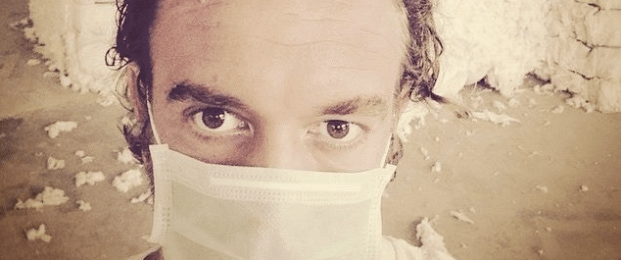20Jun2017
High street fashion may be wallet-friendly, but its environmental impact is huge. The momentum of the world’s second largest industry is increasingly drawing garment production into a race to the bottom, both in terms of pricing and quality. This unsustainable model is ripe for disruption.
The fashion industry is currently dealing with a problem of its own making. By trying to differentiate from the competition, fast-fashion brands such as H&M and Zara produce extensive inventory lists that turn over every few weeks and retail at extremely low margins, compounding consumer demand for more choice at ever lower prices. When the environmental and societal impacts of such a race are counted, the need for an alternative is clear.
Anders Bengs, a board member of Pure Waste Textiles, wants to be part of the solution. Starting in 2006 with Costo, a brand that turns leftover stocks from fabric suppliers into sustainable hats and accessories, Anders has spent his career thinking about sustainable fashion.
As environmentally conscious as Costo is, there is an inherent problem with relying on leftover fabric – suitable supplies are limited. Driven by necessity and a clear gap in the market, Pure Waste Textiles was founded with the mission to create a sustainable fabric that can be produced in high quantities, and match – or exceed – the quality of its competitors.
Nordic Business Report: Where did the idea for Pure Waste Textiles come from?
Anders Bengs: As part of our Costo work, we visited China in 2010 on a sourcing mission. One of our founders discovered a factory that was recycling pre-consumer waste from clothing production. Currently, only 15% of the various waste products generated by production are recycled.
This got us interested. The big issue with pre-consumer waste recycling is that fibers get downgraded to products like felt for use as low-grade insulation. The current recycling process is dirty and harms fibers to the point where they cannot be repurposed for consumer garments.
We started to investigate how we could recycle fibers without harming them. We began a 3-year sourcing process that took us to markets like China, India, and Bangladesh so we could broaden our understanding of how recycling is done in those countries. After 3 years of investigations, we were ready to establish Pure Waste Textiles in 2013.
Nordic Business Report: Why are the fabrics utilized in today’s fashion so low quality?
Anders Bengs: The answer is twofold. Firstly, garment production supply chains are extremely long. As an example, cotton from Uzbekistan can be spun in China, sewed in Bangladesh, and delivered to an end customer in the U.S. The result is countries only possessing the knowledge and technology needed to fulfill their step in the production chain.
Secondly, technology innovations tend to come from the western world. Most of the companies that produce textile machinery are European, but the market today only values production speed and volume. This has sadly seen textile quality drop over the past 15 years to the point where I feel it is unable to recover in its current state.
For example, if you hold good quality denim in your hands, it will often feel terrible as the fabric is so thick. However, that garment will last for 15 years. The fast fashion industry makes garments that feel perfect the first time end consumers try them on, as they will only wear them twice. They also add elastane to the yarns, which lowers garment quality but makes them feel great when you try them on for the first time.
Nordic Business Report: How can waste be repurposed into a product that is higher quality than retail garments?
Anders Bengs: Sustainability is about simplicity and quality. Our main product is a black t-shirt – it won’t go out of fashion, and we don’t follow seasonal trends and fabrics. Fast fashion brands typically come out with more than 10 collections a year. The only way to produce so many collections with a 3-week turnaround is to generate a huge amount of waste.
As I mentioned, we already recycle pre-consumer waste, but we are running a project with Aalto University and VTT who have a patent for recycling post-consumer waste (used/second-hand garments). We are aiming to blend the recovered fibers and produce high-quality yarn. We also only source 3-4 fiber colors that are pre-dyed. This means we can drastically reduce water consumption as we don’t need to dye the fibers. It also means our garments maintain their color for longer.
In terms of production, we are trying to tackle sustainability from every direction. 90% of the energy usage in our Indian units is generated by windmills, with the last 10% coming from solar panels on the factory roofs in the future. We recycle all water and waste produced on-site. We also prioritize fair worker agreements – in short, we’re aiming for the perfect business model. We are not in this for monetary profit.
Nordic Business Report: Why hasn’t the fashion world had a sustainability revolution?
Anders Bengs: There aren’t many companies doing what we’re doing. There are companies that focus on different steps of the supply chain, but in terms of the whole process, from recycling fibers to brand building, we are basically one of the only companies doing what we do – and that’s sad.
We are trying to change an industry that is unable to change at present. As long as shareholder profit is the main focus, change will be slow. A mid-scale spinning unit will cost 15-20 million euros to set up, however, the margins are pretty small and the facilities need to run 24/7 to make a profit. With people wanting to see profits in 1-2 years these days, long-term investments aren’t too attractive.
Consumers can have an impact on change, but the vast majority of people buy clothing based on price. We are trying to build a business model that enables us to compete at the same price level of fast fashion companies, but if we think about the planet and our future, clothing is too cheap.
Nordic Business Report: What’s next for Pure Waste Textiles?
Anders Bengs: We want to show the world that the whole fashion supply chain can be made transparent at production scale. We don’t have patents for any part of the production, but our in-depth supply chain knowledge means we can produce a final product that is as good quality wise as it would be from virgin material. There needs to be more investments in the field of recycling textiles.
We have a lot of work to be done in India, but by sharing our open platform with others, we hope to support more players globally. If we can help others produce an end product that is quality-wise as high as possible, that is the most sustainable thing you can do.


